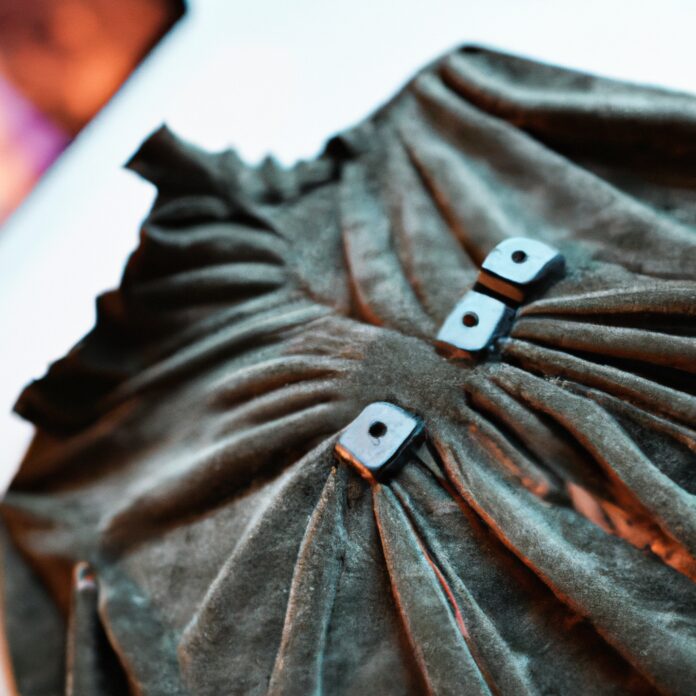Technology and fashion have always danced around one another, but now they are closer than ever before. The modern world has seen technology come into the forefront of the fashion world, with every designer striving to be ahead of the curve and add technology to their designs. Welcome to the world of Tech Meets Fashion – the fashion trend that has everyone talking. From fabric embedded with connected threads and fiber optics, to stylish watches embedded into clothing, technology has never looked so stylish. In this article, we will explore how technology is being used to breathe new life into fashion.
1. Understanding the Intersection of Tech and Fashion
The Textile Industry Reinvents Itself
There’s no denying the power of technology and its impact on the fashion industry. The traditional textile industry is being reinvented as technology and fashion converge in interesting ways. Digital printing and 3D printing are revolutionizing the types of fabrics and materials used for fashion production. IoT apps are providing modern wearables and tracking clothing histories to make more informed fashion decisions. Emergent technology such as genetic engineering are creating never-before-seen textiles that are smarter, lighter, and more durable.
High-Tech Wearables for Connected Consumers
The roads of technology and fashion have crossed in the form of retail as well. Smartwatches, wearable control buttons, and smart jewelry are bringing tech to the forefront of fashion. Designers are using technology to create pieces with comfort and convenience in mind. No longer are fashion and function mutually exclusive.
Using Technology to Shape a Sustainable Future
Thanks to technology, sustainability in fashion is as achievable as ever. Technology is transforming every aspect of the fashion industry, from production to garment life cycle. Smart fabrics are gathering data, helping us shift to a more conscious consumption model. Artificial intelligence and machine learning help brands manage their stock and forecast trends. From creating automated tracking systems to using big data to better predict inventory and production, technology is making sustainable fashion more accessible.
Data, Algorithms, and the Future of E-Commerce
Advances in technology have also revolutionized how we shop. Augmented reality platforms and digital showrooms are bridging the digital divide, giving people an immersive experience as close to seeing and wearing clothing in person as possible. Brands are tapping into the algorithm economy to leverage data to better communicate with and serve customers.
Conclusion
It’s clear that technology will continue to fuel and shape the fashion industry. Smart fabrics, digital platforms, AI-driven algorithms are just a few new technologies helping shape a smarter more sustainable fashion industry. As technology continues to evolve so will the fashion industry, pushing the boundaries of what’s possible and bringing us to a fashion future that’s bigger, bolder, and more innovative than ever.
2. How Technology is Elevating Fashion
Fashion and technology are two of the most dynamic and developing industries. Until recently, the two worked independently from each other, but with the advent of digital imaging, web streaming, and other technology-based tools, the relationship between technology and fashion has become much more intimate.
Computer-generated designs, 3D printing, digital fabrications, and smart fabrics are only some of the ways technology is making its way into the fashion industry. With enhanced automation, AI-driven analytics, and instant communication through digital media platforms, fashion professionals can communicate ideas and reach their target audiences more quickly, accurately, and efficiently.
On the consumer side, fashionistas can make better, more informed purchases with the help of downloadable apps, RFID chips, and sensory devices. Apps are becoming more and more popular due to their convenience and because they allow people to access information related to fashion from any location. RFID chips are being used to trace the product’s journey, faster checkout process, and improved customer satisfaction.
Today, technology has also changed the way fashion is marketed. The use of Augmented Reality (AR) has made it possible for customers to try out different clothes and accessories virtually. Virtual fitting rooms and personalised wardrobes are helping customers to get a better idea of what a product looks like when it’s being worn. Additionally, personalised virtual fashion shows using live streaming and other digital technologies can allow customers to experience fashion in real-time.
More and more, technology is driving the fashion industry forward. With better tools, and faster information, fashion designers are able to make their products more accessible, offer better customer experiences, and stay up-to-date with current trends. Ultimately, technology is an integral part of the fashion industry – connecting buyers and sellers, improving brand visibility, and promoting fashion through digital media channels.
3. Ways in Which Technology is Shaping the Future of Fashion
The emergence of technology has had a major influence on the fashion industry, with more and more designers incorporating cutting-edge technology into their creations. Here are some of the ways technology is changing the face of fashion:
- 3-D Printing: Many fashion designers are taking advantage of the revolutionary printing technology to produce stunning pieces of clothing. With 3-D printing, they are able to rapidly create intricate designs without having to worry about resource consumption or labor costs. This technology also allows for one-of-a-kind garments, as each piece can be saved and reproduced on demand.
- Virtual Reality (VR) and Augmented Reality (AR): Technology is revolutionizing the way shoppers buy clothes. Through the use of virtual and augmented reality, customers can now try on clothes before making their purchase, which greatly reduces the chances of an unwelcomed surprise after the package arrives at the doorstep. What’s more, stores are also using this technology to streamline the shopping experience by providing customers with a more immersive and interactive shopping environment.
- Voice and Gesture Controls: Voice control technologies such as Amazon’s Alexa and Apple’s Siri are taking the fashion industry by storm. With voice assistants, shoppers no longer need to scroll through endless catalogs to find what they’re looking for. All they need to do is use their voice to make their selection. Similarly, gesture control technologies are being used to control digital mirrors which are changing the way people try on clothes.
- Smart Fabrics: Smart fabrics are now being used to create garments that have the power to monitor the wearer’s health-related activities like heart rate, body temperature, and more. These fabrics are integrated with tiny sensors that can detect subtle changes in the wearer’s body and can even be paired with mobile apps which can then be used to analyze the data collected.
- Artificial Intelligence (AI): Artificial intelligence has been used by fashion designers to create stunning pieces of clothing with a few clicks of a button. AI can be used to generate unique designs based on a set of predetermined criteria. It can also be used to evaluate trends and consumer preferences, which allows fashion designers to create pieces that are likely to be more popular among buyers.
Technology is rapidly changing the way we view fashion and the manner in which we purchase and wear clothes. From 3-D printing, virtual reality, and gesture controls to artificial intelligence and smart fabrics, technology is revolutionizing the fashion industry in ways never seen before.
4. The Future of Tech Meets Fashion: Possibilities and Implications
A Catalyst for Change
Technology and fashion are harnessing their mutual potential to bring about a radical transformation in the way we dress. From automated sewing machines that can replace manual labor to the integration of smart materials into clothing, tech is revolutionizing the way we buy and wear fashion. With these advances, new possibilities are arising, and the implications of these options must be considered.
Impact of Automation
Automation technology is increasing efficiency in apparel production and introduces speed to production lines. This is allowing for faster turnaround times between when fashion is designed and when it hits store shelves for consumers. Autonomous robotics can also work up to 24 hours a day and produce garments with increased precision and accuracy. As the technology continues to advance, it will eventually replace human labor in production and manufacturing plants.
Integration of Smart Materials
Tech is also bringing new features to clothing such as making it interactive and providing consumers with information regarding product care through the integration of “smart materials” such as conductive paints and fibers that respond to humidity and light. These materials can interpret the wearer’s environment and allow clothing to be interactive. For example, tech-enhanced fabric can monitor the wearer’s hydrolyte balance throughout an intense workout and then stimulate cooling or heating areas of the clothing in response.
Opportunities and Challenges
The convergence of fashion and tech presents a number of opportunities and challenges for both industries. It opens the doors for creative exploration and opens up a world of possibilities for new inventions and products. But it also challenges traditional methods of production and could potentially raise ethical and economic questions. In order for tech-infused fashion to truly catch on, businesses need to create a user-friendly experience that captures the imagination of the public and encourages people to embrace tech-infused garments.
A Whole New World of Possibilities
The unique combination of fashion and tech is turning the fashion industry on its head and bringing about an entirely new realm of possibilities. From enhanced production speeds to interactive clothing, tech is providing a powerful tool for the fashion industry that is helping accelerate new innovations and products. There is no doubt that tech-infused fashion will have a major effect on the way we dress and the way we think about fashion. With fashion-tech, the future is bright and full of potential.
We’ve seen how fashion and technology have embraced a new relationship, creating unexpected and innovative styles. This fusion is sure to continue to evolve, and we can’t wait to see what trends come of it next. Through the interplay of these two forces, the possibilities are truly endless.




